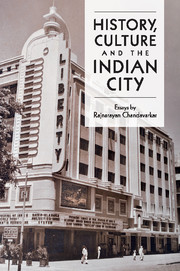Book contents
- Frontmatter
- Contents
- Acknowledgements
- Publisher's note
- Introduction by Dr Jennifer Davis, Wolfson College, University of Cambridge
- Bombay's perennial modernities
- Sewers
- Peasants and proletarians in Bombay city in the late nineteenth and early twentieth centuries
- State and society in colonial India
- Religion and nationalism in India
- From neighbourhood to nation: the rise and fall of the Left in Bombay's Girangaon in the twentieth century
- Historians and the nation
- Urban history and urban anthropology in South Asia
- Aspects of the historiography of labour in India
- Postscript by Professor David Washbrook, Trinity College, University of Cambridge
- Bibliography of the published works of Rajnarayan Chandavarkar
- Index
- References
Urban history and urban anthropology in South Asia
Published online by Cambridge University Press: 17 March 2010
- Frontmatter
- Contents
- Acknowledgements
- Publisher's note
- Introduction by Dr Jennifer Davis, Wolfson College, University of Cambridge
- Bombay's perennial modernities
- Sewers
- Peasants and proletarians in Bombay city in the late nineteenth and early twentieth centuries
- State and society in colonial India
- Religion and nationalism in India
- From neighbourhood to nation: the rise and fall of the Left in Bombay's Girangaon in the twentieth century
- Historians and the nation
- Urban history and urban anthropology in South Asia
- Aspects of the historiography of labour in India
- Postscript by Professor David Washbrook, Trinity College, University of Cambridge
- Bibliography of the published works of Rajnarayan Chandavarkar
- Index
- References
Summary
History and anthropology have been intimately, if somewhat fractiously, intertwined in the investigation of urban themes: the former borrowing promiscuously and not always profitably from the latter; anthropologists, looking increasingly for empirical support and historical depth, have often recoiled in frustration at the historian's fact fetishism. It is no longer possible to examine developments in urban studies within one discipline without reference to the other.
The particular success of urban history in the 1960s was symptomatic of a general crisis in the subject, arising though only in part from the growing interest in and development of the social sciences. While conventional political, constitutional and diplomatic history appeared increasingly narrow in scope, economic history, which for a while had offered a plausible alternative, seemed to confine itself to the application of neoclassical economic theory to data from the past. Some historians began digging in the quarries of the social sciences, framing their research in terms of their languages and taking on board their conceptual apparatus though not necessarily their techniques. Where conventional historical practice appeared to circumscribe the scope of research, a greater openness to the insights derived from sociology and social anthropology opened up an impressive range of fresh questions and lines of historical enquiry. The result was the proliferation of sub-disciplines within the subject: social history, oral history, women's history, demographic history. Urban history ranked among them.
- Type
- Chapter
- Information
- History, Culture and the Indian City , pp. 206 - 235Publisher: Cambridge University PressPrint publication year: 2009
References
- 1
- Cited by



